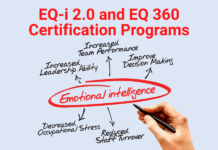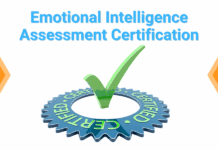
What’s the simple secret to great presence?
We’ve all met that person who seems to have that one special element: charisma, chutzpah, “it.” They seem confident and at ease, and you can’t help but hang on to their every word. What do they do that makes them so magnetic? And can we, too, become as engaging?
Jay Sullivan is an award-winning author and the managing partner at Exec|Comm, a communications skills consulting firm. His new book is Simply Said: Communicating Better at Work and Beyond. I recently interviewed Jay on the LEADx podcast to ask for a few tips on how to have a great presence. (The interview below has been edited lightly for space and clarity.)
Kevin Kruse: You say the ultimate secret to presence is actually eye contact, which surprised me. Tell us more.
Jay Sullivan: Sure. Eye contact is how you connect with people. When you think about what it means to present, it means in large part to be present to other people. One of the key ways, at least in a western business culture, is that we suggest to people that we're present to them is to maintain our eye contact with them. It doesn't mean staring somebody down. It means maintaining the eye contact in a way that says, “I'm here for you. I'm present to you.” You drop your eyes every once in a while to take a note or look at your note, not a problem, but you maintain eye contact because that allows you to feel like you're building a relationship with somebody.
When you think about it, in a presentation– a formal presentation–if you've got a couple dozen people in front of you, it's not really a conversation because the communication is going all one way. If you look out at the audience, and you make eye contact with just one person for a full thought, that's all, just a full sentence about five to seven seconds, that's long enough for that person to feel like you're talking right to them. Then you move on to the next person for a full thought and the next person for a full thought. If you try to talk to everybody at once by scanning your eyes around the room, if you're talking to everybody, you're really not talking to anyone and you lose that sense of a conversation and you lose that sense of a connection.
Kruse: If you’re speaking to a large crowd, is it still possible to keep that sense of a conversation?
Sullivan: Actually if you're talking to a large group and you look out at the back corner of the room, don't look at a group of people, zoom in on just one person in the back corner, I guarantee you everybody around that person also thinks you're looking right at them for that moment.
Then you switch to the other corner. Then you switch to somebody two rows in. Then you switch to somebody off to the side, but a full thought each. It really comes from a misinterpretation when early in our lives in any public speaking class somebody says, “Make eye contact with the audience”, people misinterpret that as “Scan the audience”, and that's really what is not going to be helpful.
Kruse: How can we become better listeners?
Sullivan: You and I are in a conversation at a meeting and when you pause, I think that's my time to jump in. Then when I pause, you jump in. You pause again, and I've got to say, “Okay, I can take over the conversation. I can tell my story. I can give a better example.” It is this fight for control of the table when we're communicating. If instead, when you finish talking I say, “Kevin, that's really interesting. Tell me a little bit more about that.” Or, “That sounds really interesting. Can you elaborate?” I give you the opportunity to keep talking. That tends to be a worldview change for people on the nature of a conversation. You don't have to fight to contribute; I'm welcoming even more from you.
Think about it. When was the last time in a conversation anybody said to you, “Wow that's really interesting, tell me more”? We build a reputation for ourselves as better listeners when we do that.
Kruse: You say that when we get an emotionally charged question from a team member who is worried, stressed, or hostile, we should remember the acronym ART. What does it stand for?
Sullivan: ART stands for, in essence, the art of responding to an emotional question. What it means is ‘Acknowledge’, ‘Relate’ and ‘Transition.’ You acknowledge the emotion in somebody's question. Very often in a business setting, emotions are considered illegitimate. We're a business, we're at work, and there shouldn't be emotions involved. Of course there are emotions involved. People are excited when things are going well. They're upset when they're not. You acknowledge the emotion to give it legitimacy. You say, “I understand you're frustrated with this. I sense your concern with regard to this issue.” You name the emotion to give it legitimacy, you ‘Acknowledge’ it.
Then you ‘Relate’ to the person, if you can, and only if you can, and only if you can do it legitimately. You don't want to pretend to relate to the person, but most of the time, people are upset about things at work for one of two reasons. They either feel like they're paying to more for something than they should have to, or they've waited too long for something and you're delayed in responding to them. We have all had instances where we felt we were overpaying for something or waiting too long for something. We can almost always identify with the frustration coming from somebody.
You relate to the person by simply saying, “I appreciate that you're concerned about this. I too would be concerned if I didn't have all the information.” Or, “I too would be frustrated if I'd had to wait and somebody had missed a deadline.”
Finally, you ‘Transition’ and you ask the person, “Would it be helpful to you if I explained why we're in this situation?” That transition allows the person to relax a little bit because if you ask it as a question, “Would it be helpful to you if we did this?” Then what happens is, they are now in control—not of the issue—but they are in control of the conversation. That sense of control allows people to calm down.
Kruse: I always like to challenge our listeners to become 1% better every single day. Is there something that you can challenge our listeners today to try out either at work or at home?
Sullivan: Absolutely. An easy one is to think in terms of how you position yourself and who you are. When people say to you, “What do you do for a living?” and both of you don't have any context for each other, you're meeting them in a social setting. So when somebody asks that, most people will explain what they do, they'll respond to that question by telling you the title on their business card. “I'm the executive director of this” or “I'm the vice president of that.” What that does is it tells people that we view ourselves in terms of a status we've achieved, which is very interesting and you should be proud of your accomplishments, but what's more effective, instead of talking to me about your title or your status, is talk to me in terms of how you add value to somebody else.
Forget your title, forget your actual job, and instead think about the impact your job has. When somebody asks, “What do you do?” the next time, start with the verb ‘help.' “I help blank, whoever it is you help, do blank.” I've never introduced myself by saying, “I'm the managing partner of Exec|Comm.” I say, “I help people improve their communication skills.” It's much more relatable to people. It gets you away from talking about yourself in terms of a status and it helps the other person see that you view yourself in terms of how you add value to the world.
—
Kevin Kruse is a New York Times bestselling author, host of the popular LEADx Leadership Podcast, and the CEO/Founder of LEADx.org, which provides free world-class leadership training, professional development and career advice for anyone, anywhere.





